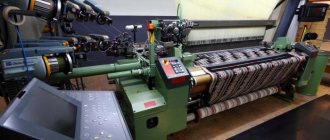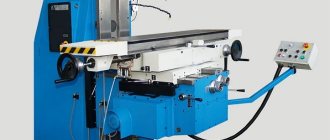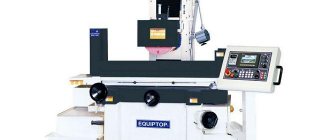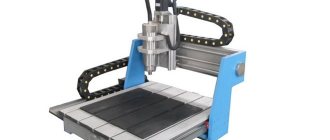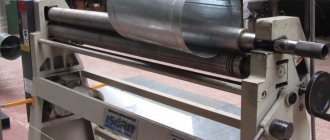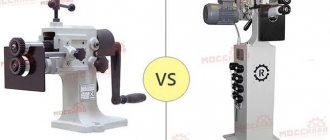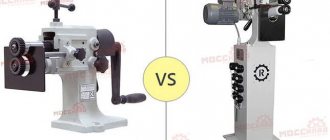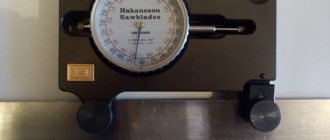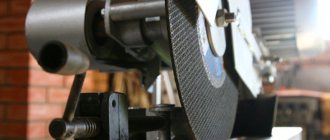Sometimes it is necessary to make a recess, a groove, or some kind of material recess on the surface of a wooden or metal part.
You can perform the operation manually, but it will be much faster and more efficient to use a slotting machine. It is intuitively clear how such a rather narrowly specialized unit works.
Professional products are expensive and are used mainly in production, but for home work you can assemble the machine yourself.
Equipment Features
You can create a metal slotting machine with your own hands only after considering the design features. The layout of a slotting machine, both professional and homemade, is identical. In this case, we highlight the following main components:
- The basis of almost any machine is the bed. It is necessary as a basis for securing all nodes and their correct positioning relative to each other. Steel can be used in the production of the frame; quite often the structure is welded from individual elements, but there are also folding versions.
- For chiselling, a tool with sharp teeth is used. They call him a dork. Its dimensions, profile and many other aspects determine the possibility of use in a particular processing case.
- The gearbox is installed on a slotting machine model, which has a wide range of applications. The transfer is necessary to change the processing parameters of the workpiece.
- The desktop can also be called one of the important design elements. The workpiece is fastened on the table. The main thing in manufacturing, when creating a homemade metal slotting machine, is to correctly position the work table relative to the cutting tool.
- It is worth considering the fact that the layout of a slotting machine can differ significantly depending on the type of installed drive: mechanical, electric, hydraulic. Often a hydraulic drive is installed on machines that are considered professional equipment. It is almost impossible to produce a hydraulic drive with your own hands. A model that you create yourself often has a mechanical drive.
- When considering the main components of a slotting machine, one should take into account the fact that the design may have a cooling system. Metal processing can lead to heating of the cutting tool and the workpiece.
Despite the fact that there are quite a lot of different models of machines on sale, many of them have a similar design.
Manual machine model
This is interesting: Rollers for profile pipes: we make manual profile bending with our own hands
DIY creation
Many people are considering how to make a metal slotting machine, since a homemade version has a lower cost, but at the same time sufficient functionality. When making it yourself, you should pay attention to the following points:
- First you need to select a drawing. You can find quite a lot of different drawings on the Internet.
- Quite often, a massive slab is used as a base, which at the same time becomes a work table. You should choose plates that are made of steel. Cast iron is susceptible to impact loads: the material may burst.
- A stand is attached to the base, which is made of a steel rod: the diameter can reach 40 mm and the height 500 mm. Fastening to the base can be done by welding or threaded connection.
- A complex structure can be called a console. It is made of two hollow cylinders.
- A separate area should be allocated for the electric motor. Quite often, homemade versions have a direct connection between the engine and the cutting tool, that is, there is no transmission.
- The drive from the electric motor to the cutting tool is a combination of a belt and rollers.
- The table drive is mechanical. Quite often the feed is carried out through a worm gear.
Familiarization with design features
A slotting machine is a hollow base that is used to hold a post in place. The structure has a column, inside of which the drive mechanisms are located. A cutter is installed on the front side of the stand, from the bottom of which a tool holder is fixed. The position of the cutter can be changed in relation to the tabletop using clamps.
The cutter will move, its stroke will determine the length of processing of the parts. The level of the cutter in relation to the workpiece can be adjusted. The slider, which has a drive, operates on hydraulic or mechanical traction. A wood slotting machine is quite simple to make; it can be used in furniture production. Such equipment is suitable for the production of any carpentry blanks.
Functions of metal slotting machines
Often, with the help of this equipment, they perform the chiselling of internal parts of flat and shaped types, as well as grooves and grooves of various workpieces . These machines are also suitable for working with different types of stamps that are placed on a table or fixed in specialized devices. Using this equipment, you can process workpiece surfaces at the required angle while maintaining the initial position of the part. This result makes it possible to rotate the frame, which serves as a location for the cutter.
The position of the table can be changed manually or mechanically. The possibility of circular feed of the table allows you to perform operations on the processing of gears or round-shaped workpieces.
When feeding, the workpiece enters the table through a movable cylinder, which is attached to the hydraulic transmission. The bed provides three options for feeding movement:
- Circular.
- Longitudinal.
- Transverse.
It is possible to change the position of the table in three directions simultaneously:
- Vertical.
- Horizontal.
- Round.
A slotting machine of any design is characterized by the presence of only two planes, which are used for feed movement. This reveals all the advantages of a hydraulic device : the user has fewer problems during the work process, and in addition to this, higher quality machining of parts is ensured.
Principle of operation
During operation of a slotting machine, two types of movements are performed: reciprocal and translational . Despite the fact that the equipment is designed to work in vertical planes, the movements it makes are rectilinear, which makes it similar to planing machines. The key role when using such a machine is given to the slotting cutter , which is fixed in the slider. The feed is provided by a table on the surface of which the workpiece is rigidly fixed.
During the use of slotting equipment, the mechanism performs reciprocating actions with some interruption. At such moments, the movements of the slotting cutter can have a curved or circular trajectory.
Slotting machines of any design are designed to operate in two slotting modes: simple and complex . In the first case, chiselling is carried out point-blank, while the cutter seems to jump to a certain area and, as a result, it is possible to obtain holes of identical size and shape.
The essence of the second mode of operation of the machine is to create an impact performed at an angle with inclined surfaces . Typically, a homemade machine is not suitable for performing such operations, so it is advisable to use a hydraulic one to solve these problems.
Such equipment is in demand in situations where there is a need to process hard-to-reach surfaces of parts. Here we are talking about surfaces located inside the part, which are used in different types of structures.
Equipment of this type is most widespread when performing work with blind grooves and grooves of various shapes . Homemade slotting machines are in demand for private workshops or small-scale production.
In large-scale industry, sophisticated processing methods have to be used. For this reason, in such situations it is necessary to use a special device designed for CNC metal processing.
If we talk about private production, workshops or service centers, then here slotting equipment is in demand for processing metals, cast iron and other metal alloys .
Among the commercially available modifications of such equipment, the most popular is the “GD” model. It can be presented in several series - 200, 500. However, each of them represents the class of devices under consideration and has the corresponding characteristics.
DIY machine
You can make your own slotting machine, with an average level of functionality, relatively quickly and cheaply, but this will require a certain manufacturing scheme. The homemade device must have a vertical layout and be manually operated. All other concepts are also feasible, but they will take much more time and resources to produce.
- First of all, you need to create a desktop for the machine. The most optimal dimensions of this structural element are in the region of 35X35X2 cm.
- A steel rod-rack with a diameter of at least 4 centimeters is attached to this work table. Its height should be from 45 to 50 cm. To attach the rod to the flange, a special groove is made at its end. A longitudinal groove is cut along the entire height of the rack.
- In our case, the flange is a large washer with a hole in the center. The element is equipped with three clamps, through which it is attached to the rack.
- The stand is threaded into the flange with its machined end and welded to it. The flange, in turn, is attached to the work table using a thread.
- A console and a holder are mounted on the rod, between which there is a compression spring.
- The console consists of two cylinder-shaped elements. They are empty inside and are connected by jumpers and welding. It is recommended to use a square pipe with a cross section of 60X60X2.5 as a jumper. Axles for the feed levers should be welded on both sides of the mandrel cylinder.
- The levers are made of steel strip with dimensions of 3 by 1 cm. The elements are attached to the axis of the cylinder and holder.
- The machine support should visually resemble a regular vice. Metal blanks are secured in a three-jaw type clamp. It is installed on the upper active pad of the caliper. It is through such a unit that the workpiece is fed to the cutting tool.
It is worth noting that, depending on the drawings used and the parameters of the finished home-made device, in one pass it is possible to process a metal workpiece to a depth of 0.3 to 0.5 mm.
Selection of factory devices
Most often, ready-made slotting machines are purchased from the “GD” model range, which is represented on the market in several series. These are rather outdated devices, which, however, have a sufficient range of functionality and are fully suitable for use in home workshops.
For higher quality and faster processing of parts, foreign-made machines are chosen. They allow you to perform a wide range of metal work.
When purchasing machines, you should pay attention not only to the manufacturer and the location of its production facilities, but also to the most important technical characteristics of the devices.
First of all, this concerns the parameters of the workpieces being processed, the power of the tool, its dimensions and functionality, and the permissible angle for tilting. The ability to move the working surfaces and the slotting unit is of great importance.
When choosing devices, always consider their future location. Small machines with medium or low power are suitable for home workshops. This will save space and energy. For production, more powerful analogues with impressive dimensions are purchased. It is also worth considering the skill level of the person who will work with this or that device.
Video: homemade desktop metal slotting machine.
Description of a metal slotting machine and its independent production
Metal slotting machines are devices designed for processing metal workpieces. Devices of this type are highly specialized machines and are capable of creating elements of various types by removing metal. Metal slotting machines can be purchased at the appropriate store or made by yourself. You can find instructions on how to create a device yourself in this article.
General characteristics of the class
Slotting machines, regardless of the conditions of their production, are always similar to each other in design features. Any machine has a bed as a key structural element. It is to it that the remaining structural elements are attached: the working surface, the slotting unit, the feed box, and the electric, mechanical or hydraulic drive.
Professional equipment differs from homemade equipment precisely in the type of drive. As a rule, factory machines are equipped with a hydraulic drive, which is almost impossible to do at home. Hydraulics significantly speed up the production process and facilitate the work of the machine operator.
At the same time, homemade devices using a mechanical or electric drive have sufficient potential to perform high-quality processing of metal workpieces.
Slotting machines are capable of performing the following functions:
- Formation of keyway grooves on various surfaces.
- Creating grooves and cutouts in various types of holes.
- Treatment of external and internal surfaces (height - up to 32 cm, depth - up to 25 cm).
In addition to the main structural elements, slotting machines have a number of additional parts and components: cooling and control systems, tanks for collecting production waste, lighting elements. The operating principle of the machine allows it to be equipped with numerical program control.
The desktop of the device can also be movable. Most often, this effect is achieved through manual or mechanical transmission. The working surface of the device can move in a straight line or in a circle. This technique allows you to significantly expand the functionality of the machine.
Most often, ready-made slotting machines are purchased from the “GD” model range, which is represented on the market in several series. These are rather outdated devices, which, however, have a sufficient range of functionality and are fully suitable for use in home workshops.
For higher quality and faster processing of parts, foreign-made machines are chosen. They allow you to perform a wide range of metal work.
When purchasing machines, you should pay attention not only to the manufacturer and the location of its production facilities, but also to the most important technical characteristics of the devices.
First of all, this concerns the parameters of the workpieces being processed, the power of the tool, its dimensions and functionality, and the permissible angle for tilting. The ability to move the working surfaces and the slotting unit is of great importance.
When choosing devices, always consider their future location. Small machines with medium or low power are suitable for home workshops. This will save space and energy. For production, more powerful analogues with impressive dimensions are purchased. It is also worth considering the skill level of the person who will work with this or that device.
: homemade desktop metal slotting machine.
DIY machine
You can make your own slotting machine, with an average level of functionality, relatively quickly and cheaply, but this will require a certain manufacturing scheme. The homemade device must have a vertical layout and be manually operated. All other concepts are also feasible, but they will take much more time and resources to produce.
- First of all, you need to create a desktop for the machine. The most optimal dimensions of this structural element are in the region of 35X35X2 cm.
- A steel rod-rack with a diameter of at least 4 centimeters is attached to this work table. Its height should be from 45 to 50 cm. To attach the rod to the flange, a special groove is made at its end. A longitudinal groove is cut along the entire height of the rack.
- In our case, the flange is a large washer with a hole in the center. The element is equipped with three clamps, through which it is attached to the rack.
- The stand is threaded into the flange with its machined end and welded to it. The flange, in turn, is attached to the work table using a thread.
- A console and a holder are mounted on the rod, between which there is a compression spring.
- The console consists of two cylinder-shaped elements. They are empty inside and are connected by jumpers and welding. It is recommended to use a square pipe with a cross section of 60X60X2.5 as a jumper. Axles for the feed levers should be welded on both sides of the mandrel cylinder.
- The levers are made of steel strip with dimensions of 3 by 1 cm. The elements are attached to the axis of the cylinder and holder.
- The machine support should visually resemble a regular vice. Metal blanks are secured in a three-jaw type clamp. It is installed on the upper active pad of the caliper. It is through such a unit that the workpiece is fed to the cutting tool.
Description of the machine 7A420
This slotting machine is mechanically driven and is used to make:
Processing can be carried out on flat and shaped surfaces in single and small-scale production. The equipment can also be used in repair workshops. The unit is designed for processing shaped and flat surfaces by chiselling. Details can be very different. The position of the element can remain unchanged if it is necessary to carry out inclined processing of the plane. This is facilitated by the rotation of the frame.
The table can be moved mechanically or manually. Circular feed makes it possible to process gears and round parts. The 7a420 slotting machine is equipped with:
- dolbyak;
- sled tilt device;
- rotating cutting head.
The latter is designed for chiselling at right angles in both directions. The device responsible for tilting the sled provides up to 5° in the vertical plane. In this process, keyways can be made in the tapered holes. As for the cutter, it can be reinstalled vertically in a range of up to 265 mm.
The equipment is highly productive, easy to maintain and operate, safe and reliable in operation. It cannot be integrated into an automatic line. The accuracy class corresponds to the letter N. The surface being processed has a roughness of at least V 6.
This is interesting: Pellet production: equipment, technology, pellet line
Professional machines
The most successful domestic models are slotting machines GD-200, GD-320, GD-500. They are designed for small-scale production of parts from flat, cylindrical, conical and shaped blanks. By chiselling and drilling you can obtain splined and grooved recesses, keyways in the most inaccessible places of workpieces.
The height of the outer surface of the workpiece corresponds to the range of machines - 200, 320 and 500 mm. The size of internal treated surfaces should not exceed 250 mm.
Note! The most modern multifunctional model is S315TGI. It has a more complex structure than the units of the GD series.
The list of functions of this model includes operations on wood and metal. It is not difficult to assemble such a slotting machine with your own hands. The fact is that, unlike artisanal ones, in professional models the carriage with the workpiece can move in any direction - horizontally, vertically, diagonally. Various equipment helps the machine operator process workpieces along two circuits - closed and open.
Compared to other types of processing units, the slotting machine can move in a straight line, in opposite directions.
The cutter (cutting element) with the cutter mounted on it moves at an angle to the vertical plane. This makes it easy to process surfaces inclined to the machine axis. This is how grooves for wedge keys are made and dies are processed. It should be noted that professional slotting machines of the latest generation are successfully used in large-scale production of wood and metal products.
The operation of the units is ensured by asynchronous motors. They facilitate complex and time-consuming processing operations. Rotational motion is transmitted directly. This allows you to maintain high efficiency and ensure high productivity. Starting is carried out using magnetic starters. They play the role of fuses in case of possible unintentional starting of the engine.
Professional slotting machines differ from simpler models in their rather massive dimensions. Their installation must be done on frames or workbenches. The machine passport must contain its main characteristics. Mechanisms and equipment of professional machines must be equipped with certificates of conformity and documents for warranty service. Professional models can be equipped with CNC equipment.
Important characteristics when choosing equipment
The main technological parameters of slotting machines include the dimensions of the working space and the metal cutting force. In addition, the same models may differ in the type of control system (indication, preset position, CNC) and additional equipment (devices for feeding workpieces, quick-clamping equipment, chip removal mechanisms, etc.). But still, when choosing a slotting machine, first of all it is necessary to analyze the following technical characteristics:
- The amount of travel of the slider. This indicator determines the maximum processing depth of the part.
- The size of the working surface of the table. The maximum dimensions of the part for a given model of slotting machine depend on it.
- Speed of movement of the slider. Usually measured in m/min, but on some models it is indicated in double strokes per minute. The metal cutting speed and, accordingly, the productivity of the machine depend on this parameter (in combination with the following).
- Maximum cutting force. It is measured in kilonewtons and directly determines the performance of the equipment, especially when cutting metal at high feed rates during roughing.
In addition to technological ones, operational indicators are also important. These primarily include power consumption, the design of lubrication systems and the type of main drive (electric or hydraulic).
Features of slotting machines
Both professional and home-made slotting machines consist of the same structural elements, which allow such equipment to effectively perform all the functions assigned to it. The basis of any slotting machine is the frame on which its other structural elements are mounted: a work table, a slotter - a tool with sharp teeth, a rocker mechanism, a feed box, a drive, which can be mechanical, electric and hydraulic.
Serial slotting machines, which are considered professional equipment, are equipped with a hydraulic drive. Working on such more advanced equipment, due to the presence of a hydraulic drive, is much easier and more convenient. A homemade machine for chiseling metal has a simpler design, but is still capable of successfully coping with many technological operations.
The operating principle of the slotting machine is demonstrated in the video:
» data-lazy-type=»iframe» src=»data:image/gif;base64,R0lGODlhAQABAIAAAAAAAP///yH5BAEAAAAALAAAAAABAAEAAAIBRAA7″>
The design of professional slotting machines has a number of other important elements: a cooling system, systems responsible for controlling the equipment and ensuring the uninterrupted operation of all components of the device. The hydraulic drive of the machine is located inside its frame, and programming its operation using a special system allows the slider, which makes reciprocating movements, to perform them according to precisely specified parameters.
A metal slotting machine allows you to perform a whole range of technological operations: forming keyways, grooves and splines on surfaces of both flat and shaped types, obtaining cuts and grooves in cylindrical and conical holes. This machine can be used to process external surfaces whose height does not exceed 320 mm, as well as internal ones with a depth of no more than 250 mm.
The movement of the worktable of this equipment can be achieved using a manual or mechanical transmission, and can also be performed in a straight line or in a circle, which makes it possible to process gears and other round-shaped metal parts on such a machine. Unlike a professional one, a homemade machine can process parts only in two planes, which significantly reduces its functionality.
» data-lazy-type=»iframe» src=»data:image/gif;base64,R0lGODlhAQABAIAAAAAAAP///yH5BAEAAAAALAAAAAABAAEAAAIBRAA7″>
Slotting machine tool
Chiseling metal
- a type of machining in which the main tool (cutter), performing reciprocating movements, processes the workpiece, thus achieving the required size, number of splines, teeth or keyway. Chiseling is a critical phase in mechanical assembly processes. Chiseling is very close to another type of processing of materials by cutting - planing.
Purpose of chiselling [edit | edit code ]
The main purpose of chiselling is:
- Treatment of external surfaces.
- Processing of internal cylindrical, multifaceted and unequal surfaces (through and “blind” holes and cavities)
- Cutting gears of both external and internal gears.
Machines and tools for chiselling [edit | edit code ]
Chiseling is a fairly precise operation when processing materials and requires significant effort, therefore the following equipment is used for chiseling:
- Vertical slotting machines: the main purpose is slotting.
- Planing machines: chiselling is an auxiliary operation and is characterized by low accuracy (note as an exception).
- Universal milling machines: slotting is performed by installing a special slotting head on the main spindle (as an auxiliary operation for small-scale and individual production).
- Slotting heads installed on vertical milling machines; now the heads are produced only in China and in the Republic of Belarus, Polotsk.
The main tool when performing chiselling is the so-called cutter. The cutter is a specially adapted and sharpened cutter installed in the cutter holder of the slotting head. During operation, the cutter makes frequent reciprocating movements (up and down) and with its cutting edge cuts off chips on the surface of the material being processed. The workpiece, in turn, makes a feed movement in manual or automatic mode. When chiselling, coolants (lubricating coolants) are used.
For the manufacture of cutters, high-speed steels and equipment with hard alloy plates are used.
Chiseling gears [edit | edit code ]
Gear wheels are chiseled on special gear shaping machines using special cutters. A gear shaper is a gear wheel equipped with cutting edges. Since it is usually impossible to cut off the entire metal layer at once, processing is carried out in several stages.
During processing, the tool makes a reciprocating movement relative to the workpiece. After each double stroke, the workpiece and the tool rotate relative to their axes. Thus, the tool and the workpiece seem to “run” against each other. After the workpiece has made a full revolution, the cutter makes a feed motion towards the workpiece.
This process continues until the entire required layer of metal is removed.
Read also: U-shaped profile
Slotting grooving machines Drilling and grooving machines are units that make it possible to make holes, grooves, grooves, tenons, sockets, etc. in wooden parts. Sometimes the cutting tool in such devices is a chisel.
Using this equipment, tongue-and-groove joints are produced. Slotting cutters are somewhat different from similar elements of a cross-planing machine. The movement can be carried out back and forth, vertically and perpendicularly. Everything else depends on the elements being processed.
In this case, the supply is usually intermittent (periodic).
Characteristic features of such units are the high level of movement of the crawling part, called the cutter, and the diameter of the working space. These parameters determine the size of the workpiece.
Processing parameters can be set using a cutter. Its positions are adjustable in relation to the surfaces being processed. Modern slotting machines have a movable slider that moves using mechanical or hydraulic drives.
Modern slotting machines are divided into two types. The first - desktop grooving and slotting machines - process workpieces with a height of no more than 100 mm. The workpiece is placed between the clamping bars and secured using a handwheel. The work table moves in transverse and vertical positions. The cutting tools are grooving attachments, drills, and chisels.
The second type - stationary slotting and drilling machines process workpieces up to 290 mm thick. Cutting tools include cutters, drills and milling cutters for professional processing. Some machine models are equipped with a 180-degree head rotation function, which allows you to work with tall parts.
When choosing a slotting machine, you should take into account the size of the workpiece and the planned tasks.
Metal slotting machines are devices designed for processing metal workpieces. Devices of this type are highly specialized machines and are capable of creating elements of various types by removing metal. Metal slotting machines can be purchased at the appropriate store or made by yourself. You can find instructions on how to create a device yourself in this article.
Read also: Voltage stabilizer 7805 switching circuit
Selection of factory devices
Most often, ready-made slotting machines are purchased from the “GD” model range, which is represented on the market in several series. These are rather outdated devices, which, however, have a sufficient range of functionality and are fully suitable for use in home workshops.
For higher quality and faster processing of parts, foreign-made machines are chosen. They allow you to perform a wide range of metal work.
First of all, this concerns the parameters of the workpieces being processed, the power of the tool, its dimensions and functionality, and the permissible angle for tilting. The ability to move the working surfaces and the slotting unit is of great importance.
When choosing devices, always consider their future location. Small machines with medium or low power are suitable for home workshops. This will save space and energy. For production, more powerful analogues with impressive dimensions are purchased. It is also worth considering the skill level of the person who will work with this or that device.
Read also: Templates for a jigsaw machine
: homemade desktop metal slotting machine.
Basic machine models
The most popular and widespread model of a metal slotting machine is the “GD”, which is represented by the 200 and 500 series. A more modern and functional slotting machine is the S315TGI model, which is also very popular among domestic manufacturers. Such a machine, in contrast to simpler models and devices made by hand, allows you to effectively perform a large list of technological operations on metal.
When choosing serial slotting machines, you cannot simply rely on promotional videos; you should take into account a number of important parameters. One of the most important characteristics is the maximum height of the workpiece that can be processed on the machine. Significant parameters of such a machine for metal are also: power, dimensions of the tool and the ability to adjust it, the presence of longitudinal and transverse stroke, permissible angle of inclination and speed parameters of the cutter. When choosing such a machine, you should also pay attention to its dimensions and weight, which affect its stability and ease of maintenance, and whether it is equipped with additional devices that significantly increase the functionality of the device.
Machine GD-500
Making a slotting machine with your own hands
To make a homemade slotting machine with your own hands, at a minimum, you need a drawing of it. Any such equipment is, in fact, a vertical planing machine with a manual drive. All structural elements of such a machine are placed on a massive base (350x350x20 mm), which is also its work table.
On the base of such a homemade machine, a stand made of a steel rod with a diameter of 40 mm and a height of 450–500 mm is fixed. A longitudinal groove is cut along the entire height of the rack, and at one of its ends there is a groove, which is necessary for connecting it to the flange. Such a flange, which is a massive washer with one central hole and three fastening holes located around its circumference, is necessary to ensure reliable fastening of the rack to the base. The stand is inserted into the flange with its machined end and securely fixed in it using a welded connection, and the flange itself is attached to the base of the machine using a threaded connection.
Drawings of a manual slotting machine, with which you can cut splines and grooves:
Homemade slotting machine
A holder and a console are mounted on the console, between which a compression spring is installed. A fairly complex device is a console, the design of which consists of two hollow cylinders: a mandrel and a rack, connected by welding with a jumper (a square pipe with a cross-section of 60x60x2.5). In each of the cylinders, a hole is made with an M12 thread, which are necessary for the fixing screw that holds the console from turning (in the rack cylinder) and for installing the locking screw in the mandrel cylinder. On two opposite sides of the rack cylinder it is necessary to weld axles for the tool feed levers, which are made from half-pins or screws with M12 threads.
Specifications
The slotting machine has a number of technical characteristics that determine the productivity, accuracy, and functionality of the equipment:
- Ability to process different materials. To work with metal, machines with a more powerful engine and hard teeth are used.
- Type of drive. Powerful models are equipped with a hydraulic system.
- Dimensions of the table for processing parts. The capabilities of the device depend on this indicator.
- Control system. There may be manual or automatic feeding of parts and equipment.
- Weight, dimensions of equipment. Industrial models are much more than compact machines for workshops.
Work tables can be stationary or located on guides for free movement under the equipment.
Disassembling a slotting machine (Photo: Instagram / kubanzheldormash)
General characteristics of the class
Slotting machines, regardless of the conditions of their production, are always similar to each other in design features. Any machine has a bed as a key structural element. It is to it that the remaining structural elements are attached: the working surface, the slotting unit, the feed box, and the electric, mechanical or hydraulic drive.
Professional equipment differs from homemade equipment precisely in the type of drive. As a rule, factory machines are equipped with a hydraulic drive, which is almost impossible to do at home. Hydraulics significantly speed up the production process and facilitate the work of the machine operator.
At the same time, homemade devices using a mechanical or electric drive have sufficient potential to perform high-quality processing of metal workpieces.
Slotting machines are capable of performing the following functions:
- Formation of keyway grooves on various surfaces.
- Creating grooves and cutouts in various types of holes.
- Treatment of external and internal surfaces (height - up to 32 cm, depth - up to 25 cm).
In addition to the main structural elements, slotting machines have a number of additional parts and components: cooling and control systems, tanks for collecting production waste, lighting elements. The operating principle of the machine allows it to be equipped with numerical program control.
The desktop of the device can also be movable. Most often, this effect is achieved through manual or mechanical transmission. The working surface of the device can move in a straight line or in a circle. This technique allows you to significantly expand the functionality of the machine.
Varieties
If we talk about the types of slotting machines, we can distinguish two groups:
- Models for private workshops, garages. They are small-sized machines that can be installed on a workbench or have a steel base. Operated manually. To do this, the master installs the workpiece and clamps it with clamps. Next, he starts the machine and manually lowers the working part with the equipment to the workpiece.
- Industrial equipment. These are large-sized machines that are used for mass production of parts. The grooving machine is equipped with movable work tables, a powerful engine, and a cooling system.
Recommendations for selection
Before buying metal slotting machines, it is necessary to take into account a number of factors on which the principle of operation in the future will depend:
- Power of the engine installed on the equipment. The more powerful it is, the higher the performance of the machine. However, as power increases, energy consumption increases.
- Dimensions, type of equipment installed on the working part.
- Equipment dimensions.
- Desk dimensions.
- Maximum permissible dimensions of the workpiece. The functionality of the machine depends on this.
- Possibility of adjusting the feed speed of equipment.
- Control system - manual or automatic.
When choosing industrial equipment, it is necessary to take into account the presence of a cooling system. It will protect parts from damage and equipment from deformation.
Slotting machine with automatic control system (Photo: Instagram / instrumentedison)
Details
Wood slotting machines have a relatively simple structure, which allows you to make them yourself. Most of the elements for creating such a device yourself can be found in a home workshop. To make a slotting machine at home you will need:
- Electric motor (for example, from an old washing machine).
- Channel.
- Two corners with dimensions 30X30 and 50X50.
- A piece of thick plywood.
- 4 nuts.
- Bolts.
- Tripods.
- Pipe sections.
To correctly design a machine, you must have the basic skills of a welder and turner. At the same time, you should not overuse welds, because they tend to deform under constant loads or vibrations. If you know that you cannot weld structural elements yourself, then seek help from a friend who has great skills in this area.
Homemade machines
A homemade wood chisel is not that difficult to make if you really want to. Of course, it will be much inferior to its factory analogues, but it can handle standard wooden products for a summer house or home, plus the price of such an assistant is several times lower than its serial analogues.
Hand cutter for the machine.
It is most convenient to make a wood cutter using a hand cutter. Of course, in the absence of one, you can use an electric motor of appropriate power or a powerful electric drill, but in these cases you should not count on long-term and high-quality work, because they are not adapted to constant lateral load on the shaft.
Small platform for the cutter.
Initially, the router is rigidly mounted in a horizontal position. This way, during the work, we will be able to clearly see the cutter and the selected groove itself. Plus, with a horizontal stroke level, it is much easier to make a series of identical holes.
Assembly of components, side view.
Thick plywood from 10 mm is used as a basis. Platform dimensions vary depending on the dimensions of your router. The tool is installed strictly horizontally, level, the accuracy of the work performed depends on this. For rigid fixation, two identical bars are placed under the handles of the router, the entire structure is pressed with a metal pin, as in the photo.
Assembly of units, top view.
In principle, you can already work with such a device, but you will have to adjust the depth and size of the hole yourself. To ensure relative accuracy and the ability to make identical parts, a small improvement will be needed.
Lever device.
To ensure controlled transverse and longitudinal movement of the tool, you need to install 2 levers with a perpendicular guide vector. Provided that we already have a stationary frame, we will need another 1 sheet of larger plywood for arrangement.
Installation of platforms on the frame.
On a larger sheet, behind the platform with the router, a block with a lever is rigidly fixed. Another block is attached to the platform to movably fix the rod. The movement is carried out through the rod between the lever and the platform. Thus, we gain the ability to control depth.
Fixing the block with clamps.
To ensure transverse movement, a similar lever is fixed to the frame, only now it is connected by a rod to a large sheet and will move perpendicularly. Since plywood is a thin material, you will also have to secure a block for the rod on a larger sheet.
This device can be improved by installing guide slides made of thin wooden blocks. The above operating principle can be mirrored in table arrangements. In this case, the cutter will be stationary, and the selection will be carried out due to the movement of the table.
Homemade machine made from an electric motor.
The video in this article shows the operation of a slotting machine.
What does the device consist of?
Both the homemade machine and the professional machine have the same content that allows the device to function.
Each device has a frame on which there is a table, a cutter equipped with sharp teeth, which is a tool for operating the device, a rocker mechanism with a box responsible for the speed of feeding, as well as a drive of one of three types (can be hydraulic, mechanical and electric).
A machine made by yourself is simpler, but professional hydraulic machines are more advanced, and it’s easier to work with your own hands.
The mechanism of such a machine also includes several component units: it operates thanks to a hydraulic system, a system responsible for cooling, a bed, a slotting cutter, a feed box, a table, a control system and equipment that is responsible for the operation of the system.
The hydraulic drive itself must be inserted into the frame; the device programs the forward and backward movements, which are performed by the slider.
This type of machine is used to create keyways, splines and grooves mounted on shaped or flat surfaces.
It is also used to work with flat or shaped surfaces, to create cuts and grooves for holes in the shape of a cylinder or cone, as well as to perform chiselling with undercuts at the required degree (but not more than 10).
The machine can be used to process the external surface of parts not exceeding a height of 320 mm, as well as the internal space - up to 250 mm.
The machine can be used for private or small-scale production, as well as in private workshops.
The machine is equipped with three types of table feeding capabilities, which allows you to work on a machine with multiple surfaces using only one type of installation.
The machine is also capable of multi-machine operation thanks to its table capabilities, programmed stop system and remote control.
The device is used to process, by chiselling, internal parts of flat and shaped types, grooves and grooves of various parts, as well as types of dies installed on the table itself, or fixed in specialized devices.
The machine is capable of processing the surface of parts at an angle without changing the original position of the part, due to the fact that the frame on which the cutter is located can be rotated.
The table can be moved both manually and mechanically, and thanks to the circular feed of the table, the machine can process gears or round-shaped parts.
The feed passes into the table through a movable cylinder connected to the hydraulic transmission.
The frame has three options for how the feed can move: circular, longitudinal and transverse - thanks to them, the table can be moved in three different directions at once: vertically, horizontally or in a circle.
A conventional or self-made device has only two planes along which the feed moves, so the advantages of a hydraulic device are obvious: it is easier to work with and the quality of the parts will be higher.
